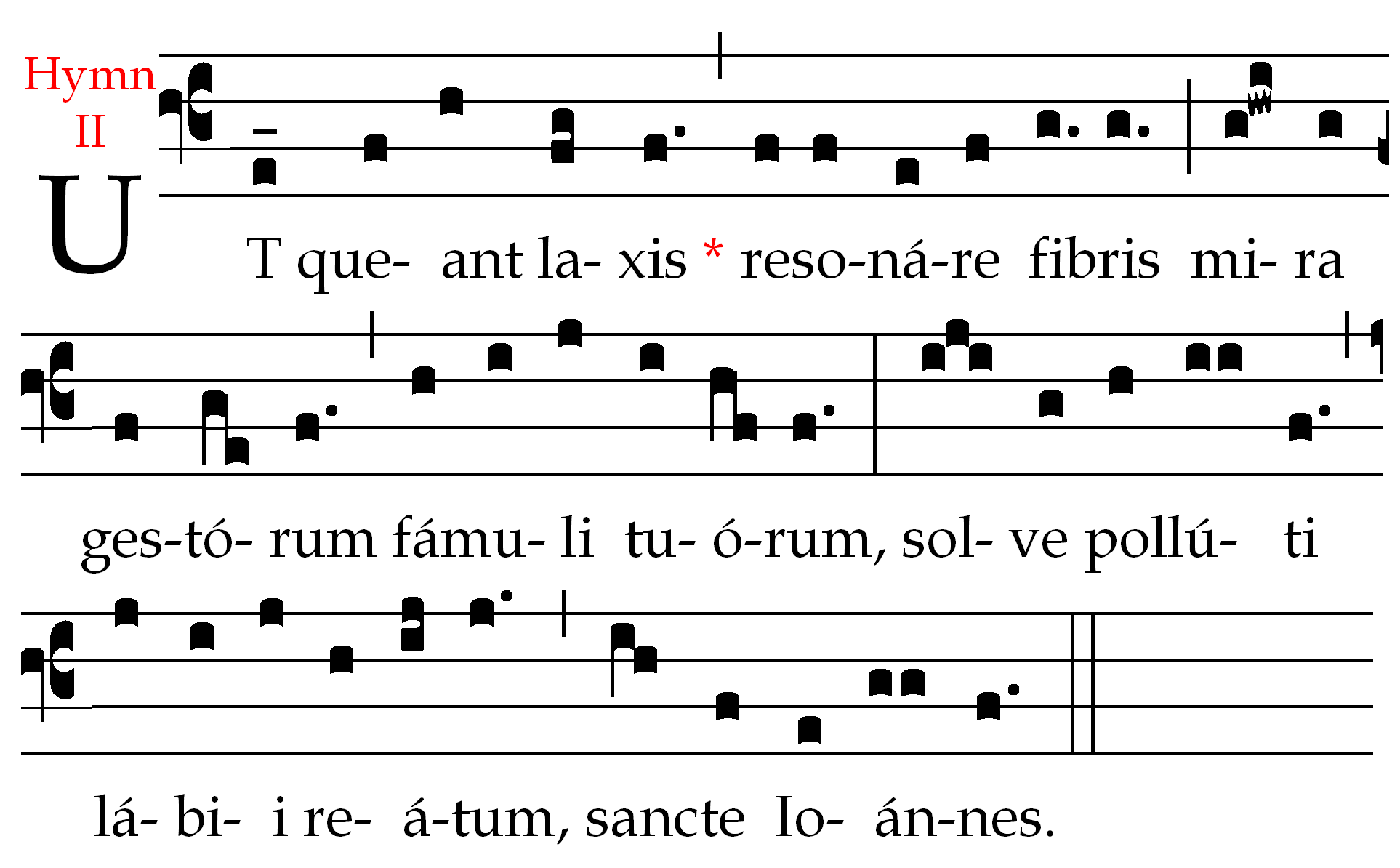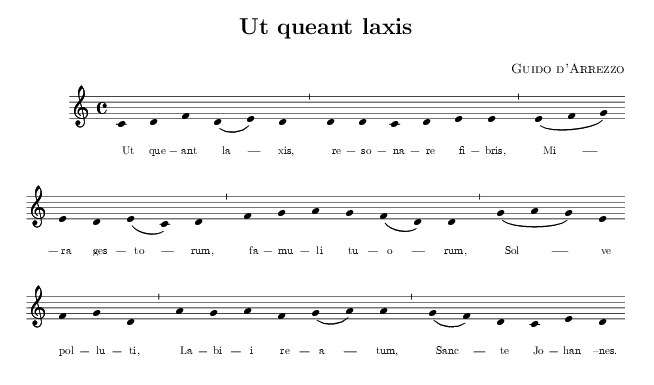Ut Queant Laxis on:
[Wikipedia]
[Google]
[Amazon]

 "" or "" is a
"" or "" is a
in ''Encyclopédie Larousse'' but he more likely used an existing melody. A variant of the melody appears in an eleventh-century musical setting of Horace's poem ''Ode to Phyllis'' ( 4.11) recorded in a manuscript in France.
Ut queant laxīs
resonāre fibrīs
Mīra gestōrum
famulī tuōrum,
Solve pollūtī
labiī reātum,
Sāncte Iohannēs.
It may be translated: ''So that your servants may, with loosened voices, resound the wonders of your deeds, clean the guilt from our stained lips, O Saint John.''
A paraphrase by Cecile Gertken, OSB (1902–2001) preserves the key syllables and loosely evokes the original meter:
Do let our voices
resonate most purely,
miracles telling,
far greater than many;
so let our tongues be
lavish in your praises,
Saint John the Baptist.Gertken, Cecile: ''Feasts and Saints'', 1981
''Ut'' is now mostly replaced by ''Do'' in
Full text, translation and some polyphonic settings
at
a short account
at Catholicculture.org
{{DEFAULTSORT:Ut Queant Laxis 11th century in music Christian hymns in Latin Musical notation

 "" or "" is a
"" or "" is a Latin
Latin ( or ) is a classical language belonging to the Italic languages, Italic branch of the Indo-European languages. Latin was originally spoken by the Latins (Italic tribe), Latins in Latium (now known as Lazio), the lower Tiber area aroun ...
hymn
A hymn is a type of song, and partially synonymous with devotional song, specifically written for the purpose of adoration or prayer, and typically addressed to a deity or deities, or to a prominent figure or personification. The word ''hymn'' d ...
in honor of John the Baptist
John the Baptist ( – ) was a Jewish preacher active in the area of the Jordan River in the early first century AD. He is also known as Saint John the Forerunner in Eastern Orthodoxy and Oriental Orthodoxy, John the Immerser in some Baptist ...
, written in Horatian Sapphics with text traditionally attributed to Paulus Diaconus, the eighth-century Lombard historian. It is famous for its part in the history of musical notation
Musical notation is any system used to visually represent music. Systems of notation generally represent the elements of a piece of music that are considered important for its performance in the context of a given musical tradition. The proce ...
, in particular solmization. The hymn belongs to the tradition of Gregorian chant
Gregorian chant is the central tradition of Western plainsong, plainchant, a form of monophony, monophonic, unaccompanied sacred song in Latin (and occasionally Greek language, Greek) of the Roman Catholic Church. Gregorian chant developed main ...
.
It is not known who wrote the melody. Guido of Arezzo
Guido of Arezzo (; – after 1033) was an Italian music theorist and pedagogue of High medieval music. A Benedictine monk, he is regarded as the inventor—or by some, developer—of the modern Staff (music), staff notation that had a massive ...
possibly composed it,Ut queant laxisin ''Encyclopédie Larousse'' but he more likely used an existing melody. A variant of the melody appears in an eleventh-century musical setting of Horace's poem ''Ode to Phyllis'' ( 4.11) recorded in a manuscript in France.
Structure
The hymn uses classicalmetre
The metre (or meter in US spelling; symbol: m) is the base unit of length in the International System of Units (SI). Since 2019, the metre has been defined as the length of the path travelled by light in vacuum during a time interval of of ...
s: the Sapphic stanza
The Sapphic stanza, named after the Ancient Greek poet Sappho, is an Aeolic verse form of Quatrain, four lines. Originally composed in quantitative verse and unrhymed, imitations of the form since the Middle Ages typically feature rhyme and accen ...
consisting of three Sapphic hendecasyllables followed by an adonius (a type of dimeter).
The chant is useful for teaching singing because of the way it uses successive notes of the scale: the first six musical phrases of each stanza
In poetry, a stanza (; from Italian ''stanza'', ; ) is a group of lines within a poem, usually set off from others by a blank line or indentation. Stanzas can have regular rhyme and metrical schemes, but they are not required to have either. ...
begin on a successively higher notes of the hexachord
In music, a hexachord (also hexachordon) is a six- note series, as exhibited in a scale ( hexatonic or hexad) or tone row. The term was adopted in this sense during the Middle Ages and adapted in the 20th century in Milton Babbitt's serial t ...
, giving ''ut–re–mi–fa–so–la''; though ''ut'' is replaced by ''do'' in modern solfège
In music, solfège (British English or American English , ) or solfeggio (; ), also called sol-fa, solfa, solfeo, among many names, is a mnemonic used in teaching aural skills, Pitch (music), pitch and sight-reading of Western classical music, W ...
. The naming of the notes of the hexachord
In music, a hexachord (also hexachordon) is a six- note series, as exhibited in a scale ( hexatonic or hexad) or tone row. The term was adopted in this sense during the Middle Ages and adapted in the 20th century in Milton Babbitt's serial t ...
by the first syllable of each hemistich (half line of verse) of the first verse is usually attributed to Guido of Arezzo
Guido of Arezzo (; – after 1033) was an Italian music theorist and pedagogue of High medieval music. A Benedictine monk, he is regarded as the inventor—or by some, developer—of the modern Staff (music), staff notation that had a massive ...
. Guido, who was active in the eleventh century, is regarded as the father of modern musical notation. He made use of clefs (C & F clefs) and invented the ''ut-re-mi-fa-sol-la'' notation. The hymn does not help with the seventh tone as the last line, ''Sancte Iohannes'', breaks the ascending pattern. The syllable ''si'', for the seventh tone, was added in the 18th century.
The first stanza is:
solfège
In music, solfège (British English or American English , ) or solfeggio (; ), also called sol-fa, solfa, solfeo, among many names, is a mnemonic used in teaching aural skills, Pitch (music), pitch and sight-reading of Western classical music, W ...
due to the latter's open
Open or OPEN may refer to:
Music
* Open (band), Australian pop/rock band
* The Open (band), English indie rock band
* ''Open'' (Blues Image album), 1969
* ''Open'' (Gerd Dudek, Buschi Niebergall, and Edward Vesala album), 1979
* ''Open'' (Go ...
sound, in deference to Italian theorist Giovanni Battista Doni.
The word "Ut" is still in use to name the C-clef. The seventh note was not part of the medieval hexachord and does not occur in this melody, and it was originally called "si" from "Sancte Ioannes" (Johannes
Johannes is a Medieval Latin form of the personal name that usually appears as " John" in English language contexts. It is a variant of the Greek and Classical Latin variants (Ιωάννης, '' Ioannes''), itself derived from the Hebrew name '' Y ...
). In the nineteenth century, Sarah Glover, an English music teacher, renamed "si" to "ti" so that every syllable might be notated by its initial letter. But this was not adopted in countries using fixed do solfège: in Romance languages "si" is used alike for B and B flat, and no separate syllable is required for sharp "sol".
Liturgical use
In theRoman Rite
The Roman Rite () is the most common ritual family for performing the ecclesiastical services of the Latin Church, the largest of the ''sui iuris'' particular churches that comprise the Catholic Church. The Roman Rite governs Rite (Christianity) ...
, the hymn is sung in the Divine Office on June 24, the Feast of the Nativity of John the Baptist
John the Baptist ( – ) was a Jewish preacher active in the area of the Jordan River in the early first century AD. He is also known as Saint John the Forerunner in Eastern Orthodoxy and Oriental Orthodoxy, John the Immerser in some Baptist ...
. The full hymn is divided into three parts, with "Ut queant laxis" sung at Vespers
Vespers /ˈvɛspərz/ () is a Christian liturgy, liturgy of evening prayer, one of the canonical hours in Catholic (both Latin liturgical rites, Latin and Eastern Catholic liturgy, Eastern Catholic liturgical rites), Eastern Orthodox, Oriental O ...
, "Antra deserti" sung at Matins, "O nimis felix" sung at Lauds
Lauds is a canonical hour of the Divine office. In the Roman Rite Liturgy of the Hours it is one of the major hours, usually held after Matins, in the early morning hours (between 3:00:00 and 5:59:59).
Name
The name is derived from the three la ...
, and doxologies added after the first two parts.
See also
*Diatonic and chromatic
Diatonic and chromatic are terms in music theory that are used to characterize Scale (music), scales. The terms are also applied to musical instruments, Interval (music), intervals, Chord (music), chords, Musical note, notes, musical styles, ...
* Do-Re-Mi (song). The lyrics teach the solfege syllables by linking them with English homophones (or near-homophones)
* Gamut
In color reproduction and colorimetry, a gamut, or color gamut , is a convex set containing the colors that can be accurately represented, i.e. reproduced by an output device (e.g. printer or display) or measured by an input device (e.g. cam ...
* Guidonian hand
The Guidonian hand was a mnemonic device used to assist singers in learning to sight reading, sight-sing. Some form of the device may have been used by Guido of Arezzo, a medieval music theory, music theorist who wrote a number of treatises, incl ...
* Solmization
References
External links
Full text, translation and some polyphonic settings
at
Choral Public Domain Library
The Choral Public Domain Library (CPDL), also known as the ChoralWiki, is an online database for choral and vocal music. Its contents primarily include sheet music in the public domain or otherwise freely available for printing and performing ...
a short account
at Catholicculture.org
{{DEFAULTSORT:Ut Queant Laxis 11th century in music Christian hymns in Latin Musical notation